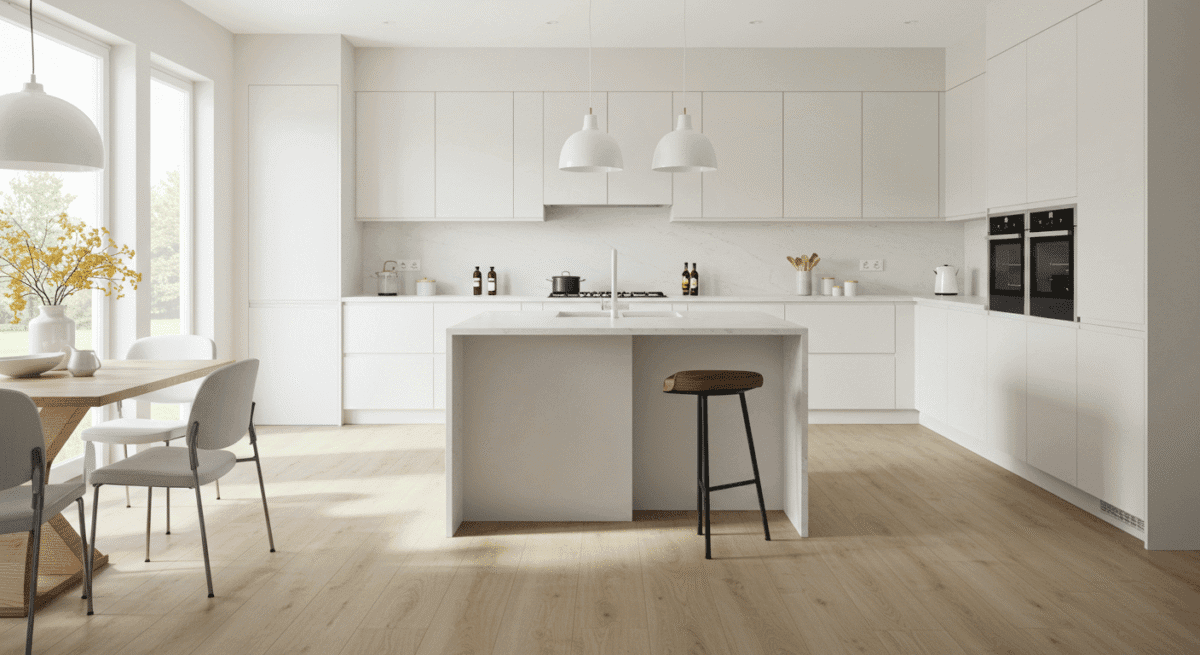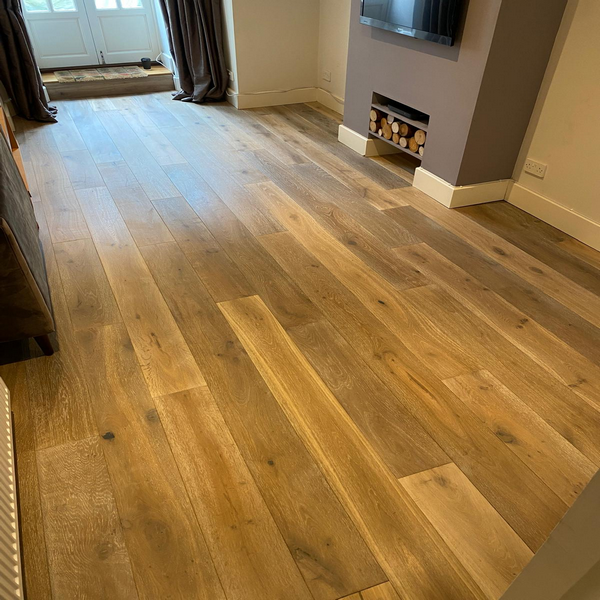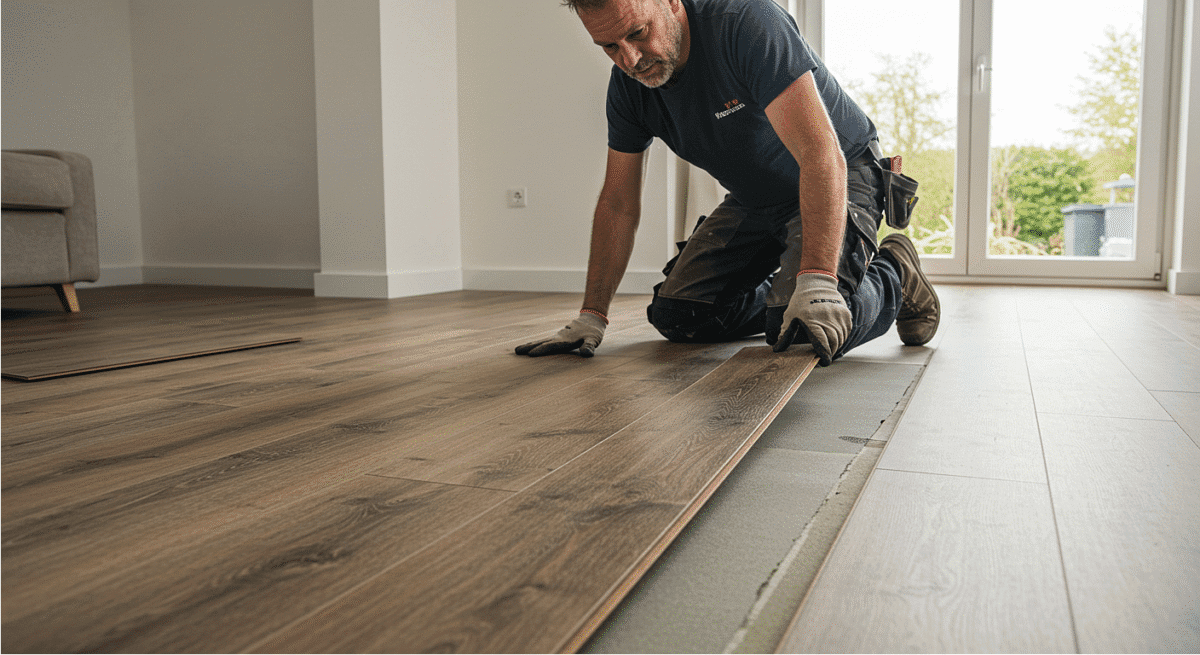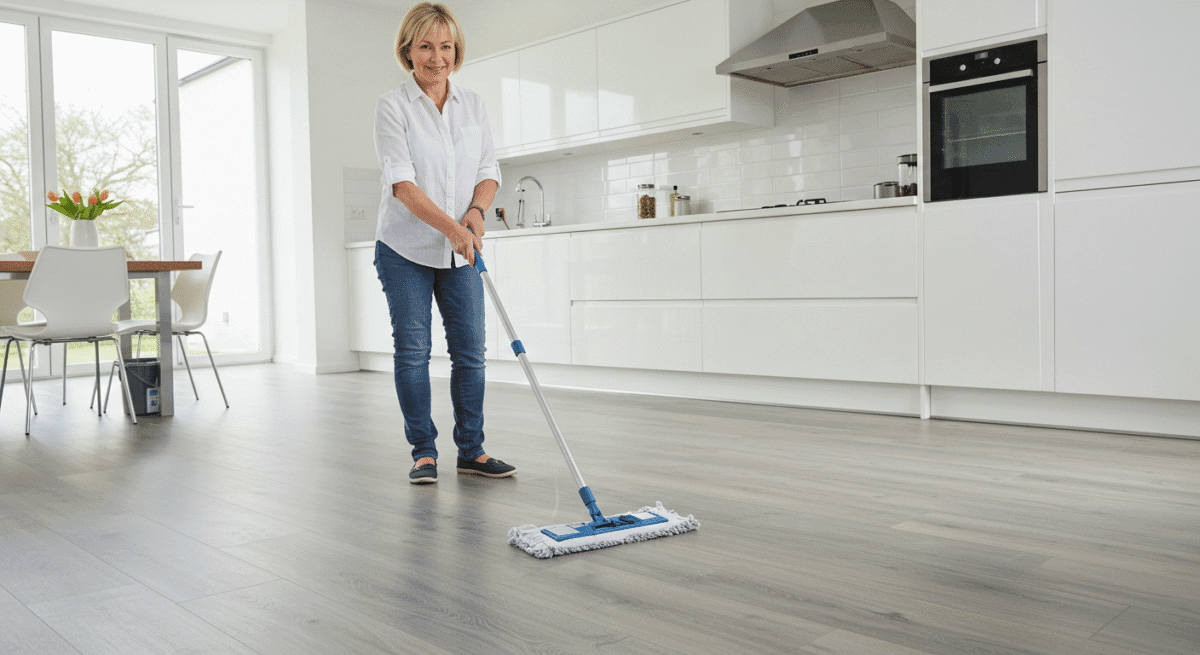Table of Contents
Your home deserves flooring that not only looks stunning but adds real value too. Wood flooring can boost your property’s market value considerably – prospective buyers often pay extra for homes with quality wooden floors. That makes it a smart investment for your living space.
Wood flooring has come a long way, giving you more choice than ever before. Solid wood flooring costs between £55 to £95 per square metre for high-quality options, whilst engineered alternatives start around £30 per square metre. But choosing the best wood flooring isn’t just about price. You’ll want to consider durability, looks, and which rooms you’re planning to use it in.
The Janka Hardness Scale measures how tough different wood species are – perfect for helping you decide what works best in busy hallways versus quiet bedrooms. Wood flooring also comes in four grades: Prime, Select, Natural, and Rustic. Each one shows off different natural characteristics rather than quality levels.
Whether you love the classic appeal of oak or you’re thinking about engineered wood’s extra stability (it has at least three timber layers for better moisture resistance), this straightforward guide will help you make the right choice. Let’s discover what you need to know about buying wood flooring and picking the perfect option for your home.
Understanding the Main Types of Wood Flooring
What’s the best wood flooring for your home? Understanding the different types available will help you make the right choice. Each option brings its own benefits and challenges that affect how long it lasts, how you install it, and what maintenance you’ll need.
Solid wood flooring
Solid wood flooring is cut from a single piece of timber, typically 18-20mm thick. Made entirely from hardwood species like oak, walnut, or maple, this flooring delivers authentic character that’s impossible to fake. The major advantage? Longevity – with proper care, solid wood floors can last 50 to 100 years. You can sand and refinish them multiple times to remove damage and restore that original beauty.
However, solid wood doesn’t like temperature changes or humidity. That makes it unsuitable for bathrooms, kitchens, or anywhere you want underfloor heating. It works best in living rooms, dining areas, and bedrooms.
Engineered wood flooring
Engineered wood flooring offers a clever alternative with its multi-layered construction. It features a real wood veneer (typically 2-6mm thick) bonded to high-quality plywood layers arranged in opposing directions. This smart structure gives you superior stability against moisture and temperature changes.
Unlike solid wood, engineered flooring works brilliantly with underfloor heating systems and can handle kitchens. How many times can you refinish it? That depends on the veneer thickness – a 4mm layer generally allows for two refinishing cycles, whilst a 6mm layer can be refinished just as many times as solid wood.
Laminate and wood-effect alternatives
Looking for a budget-friendly option? Laminate flooring starts from just £8 per square metre. It consists of a fibreboard core topped with a photographic wood-effect layer and protective coating. Modern manufacturing has dramatically improved how realistic these look, though the lifespan remains shorter at 15-25 years.
Other alternatives include luxury vinyl planks, which offer waterproof properties perfect for moisture-prone areas, and wood-look ceramic tiles that resist scratches and water damage whilst mimicking timber appearance.
Reclaimed and sustainable options
Reclaimed wood flooring uses timber salvaged from old buildings and structures, giving it distinctive character and patina you simply can’t recreate artificially. Beyond the aesthetic appeal, choosing reclaimed wood reduces demand for newly harvested timber, making it an environmentally responsible choice.
Bamboo presents another sustainable alternative worth considering. Unlike hardwood trees that take decades to mature, bamboo grows rapidly and regrows after harvesting, offering a renewable flooring material that’s surprisingly durable and resistant to moisture.
How do you choose the best wood for your home?
Picking the right wood flooring goes beyond just loving how it looks. You need to think about practical stuff too – after all, your choice will affect your daily life and how happy you’ll be with your investment for years to come.
Which rooms get the most action?
Your flooring needs depend on how much your rooms get used. High-traffic spots like hallways, living rooms, and kitchens need tougher options. For these busy areas, go for:
• Harder wood species that won’t dent and scratch easily • Engineered wood with a thick wear layer • Darker colours and bold grain patterns that hide minor damage better
Bedrooms and guest rooms are much gentler on floors, so you can choose softer woods and lighter colours without worrying about wear.
What about moisture and temperature?
Moisture resistance should be top of your list, especially for kitchens and bathrooms. Traditional solid wood can warp in humid spots, but specially designed waterproof wood flooring offers much better protection. Some modern options can handle water on the surface for up to 72 hours without damage.
For kitchens and bathrooms, engineered wood usually beats solid wood hands down because it’s more stable. Certain woods like teak, cedar, and white oak have natural oils that work as moisture barriers too.

Does your wood match your style?
Your wood flooring becomes the star of your interior design. Keep a consistent colour palette throughout your home for the best results, even if you use different flooring types in different rooms.
Satin finish gives you the most flexibility – it looks elegant but stays practical, shows fewer scratches, and you’ll find it easier to maintain than other finishes. Want visual variety without clashing? Try different plank widths and lengths instead of mixing wood species or colours.
What should you budget for quality wood flooring?
Quality wood flooring costs serious money. Solid hardwood typically starts around £80 per square metre, whilst engineered options begin at roughly £50 per square metre.
Don’t forget these extra costs when you’re planning your budget:
- Underlayment and moisture barriers
- Professional installation (around £250 per day)
- Future maintenance expenses
- Special prep work for unusual rooms
The initial cost might make you gulp, but durable wood flooring gives excellent value through its longevity and timeless appeal.
Which grade and finish will suit your style?
Once you’ve chosen your wood type, you’ll want to think about grades and finishes. These choices will shape how your floors look and feel in your home. The visual appeal of your wooden floor makes a huge difference to your room’s atmosphere.
Understanding wood grades – it’s not about quality
Here’s something that catches many people off guard: wood grades don’t reflect quality or durability. They’re all about appearance and natural characteristics.
Prime grade gives you that clean, uniform look with minimal knots – perfect if you love contemporary interiors. Select grade offers a lovely balance, featuring slightly more knots up to 20mm and around 10% sap content. You get character without it being overwhelming.
Natural grade steps things up with knots up to 30mm and moderate colour variation, whilst Rustic grade celebrates wood’s natural beauty with abundant knots up to 35mm and pronounced colour differences. Rustic creates that authentic countryside feel that’s impossible to fake.

Should you choose prefinished or unfinished wood?
Prefinished wood arrives ready to walk on. It’s sanded, stained and sealed at the factory, so there’s no mess or strong chemical smells in your home. Factory finishes often last longer too – many come with 25-year warranties thanks to their aluminium oxide sealers embedded in UV-cured urethane coats.
Unfinished wood needs finishing on-site but gives you more control over the final look. Although it costs less initially, you’ll need to factor in finishing expenses. Most homeowners find the total cost comparable to prefinished options, but with more disruption during installation.
Lacquered, oiled or brushed – which finish works best?
Your finish choice affects both looks and maintenance. Lacquered finishes create a protective surface layer that resists moisture and wear brilliantly. Modern lacquers aren’t just glossy anymore – you can choose matt options too. Expect lacquered floors to last 10-20 years before needing refinishing.
Oil finishes soak into the wood, bringing out its natural grain and texture. They’re easier to touch up when damaged, but you’ll need to maintain them more often – sometimes every six months. Brushed finishes physically enhance the grain pattern, creating a gorgeous textured surface you can actually feel.
How do colours and patterns affect your room?
Your colour choice completely changes how a room feels. Dark floors bring warmth and cosiness but soak up light, making spaces feel smaller. Lighter woods bounce light around and open up your room.
The grain pattern matters just as much. Straight grains give a clean, modern feel. Wavy patterns add gentle movement, whilst knotty woods create visual interest and character. Consider how much pattern you want – sometimes simple works better in busy rooms, whilst bedrooms can handle more dramatic grain patterns.
Installation and Maintenance Essentials

Proper installation and care will determine how long your wood flooring investment lasts. Follow professional guidelines during these stages and you’ll preserve your floor’s beauty for decades.
Preparing the subfloor and acclimating wood
Your subfloor needs to be clean, dry, and level before installation starts. Concrete subfloors should have moisture content no more than 2-3%, whilst wooden subfloors need readings of 16% or below using a moisture metre. Got uneven areas exceeding 3mm? Use self-levelling compound for concrete or plywood lining for wooden subfloors.
Don’t skip acclimation – it lets wood adjust to your home’s environment. Place unopened flooring packages flat in the installation room for 48-72 hours. Keep room temperature between 18-24°C with relative humidity between 45-65% during this period.
Nail-down, glue-down or floating methods
Each installation method works for different situations:
- Nail-down: Perfect for solid wood over wooden subfloors. Offers excellent stability but won’t work for concrete subfloors or underfloor heating.
- Glue-down: Works with both solid and engineered wood on any subfloor type. Gives you the most stable results, especially important with underfloor heating.
- Floating: Easiest DIY option where boards connect to each other rather than the subfloor. Best for engineered wood and laminate, not solid hardwood.
Basic cleaning and long-term care tips
Daily maintenance is simple – sweep or dust mop regularly to stop dirt and grit scratching your floor. Then vacuum weekly with a canister vacuum, turning off rotating brushes if you’re using an upright model.

Need deeper cleaning? Use specific products based on your finish type – lacquered floors need synthetic cleaners without grease, whilst oiled floors require soap-based cleaners containing grease.
When and how to refinish your floor
Think about refinishing when you notice worn finishes, faded colour, scratches, dullness, or stickiness underfoot. Try a simple water drop test – if water soaks in immediately rather than beading on the surface, refinishing is needed.
Professional refinishing involves sanding the floor through multiple grits, filling damages, and applying new stain and sealant. Solid hardwood can generally be refinished 4-6 times during its lifespan, roughly every 7-10 years.
Making Your Final Decision
Choosing wood flooring for your home can feel overwhelming with so many options available. But don’t worry – your lifestyle, budget, and personal style will guide you to the right choice. Solid wood gives you authenticity that lasts for generations, whilst engineered options work brilliantly in trickier spaces like kitchens or rooms with underfloor heating.
Yes, quality wood flooring requires a significant investment. But it’s one that rewards you with increased property value and decades of beautiful floors. Take your time weighing up the practical bits – how much wear your floors will get, any moisture concerns, and how much maintenance you’re happy to do – against the look you’re after.
Don’t forget that wood grades show character, not quality. You might discover that rustic grades suit your country-style home perfectly, even though they cost less than prime grades. Your finish choice should balance the appearance you want with how much upkeep you can manage.
Professional installation makes sense for most people, whatever flooring type you choose. And starting good maintenance habits from day one will keep your floors looking gorgeous for years.
The perfect wood flooring matches your practical needs with what makes you smile every time you see it. Whether you go for classic oak, eco-friendly bamboo, or characterful reclaimed timber, your new wooden floor will become the foundation of your home’s personality for decades to come.
FAQs
Q1. What are the main types of wood flooring available? There are several types of wood flooring, including solid wood, engineered wood, laminate, and reclaimed wood. Solid wood is made from a single piece of timber, engineered wood has a real wood veneer over plywood layers, laminate is a budget-friendly option with a wood-effect layer, and reclaimed wood offers unique character from salvaged timber.
Q2. How do I choose the best wood flooring for high-traffic areas? For high-traffic areas like hallways and living rooms, opt for harder wood species that resist dents and scratches. Engineered wood with a thick wear layer is also a good choice. Consider darker colours and pronounced grain patterns as they better disguise minor damage.
Q3. Can wood flooring be installed in bathrooms and kitchens? While traditional solid wood isn’t suitable for moisture-prone areas, engineered wood flooring can be installed in kitchens. For bathrooms, specially designed waterproof wood flooring or wood-look alternatives like luxury vinyl planks are better options due to their superior moisture resistance.
Q4. What’s the difference between prefinished and unfinished wood flooring? Prefinished wood comes already sanded, stained, and sealed from the factory, allowing for immediate use after installation. Unfinished wood requires on-site finishing, offering greater customisation options but potentially more mess and longer installation time.
Q5. How often should wood flooring be refinished? The frequency of refinishing depends on wear and tear, but generally, solid hardwood can be refinished 4-6 times during its lifespan, approximately every 7-10 years. Signs that refinishing is needed include worn finishes, faded colour, scratches, dullness, or if water soaks in immediately rather than beading on the surface.